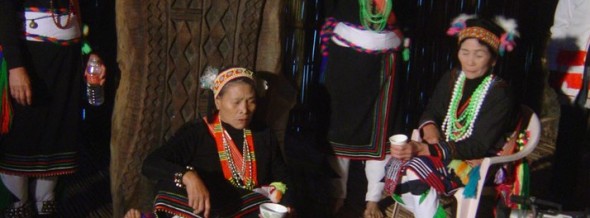Review of ‘Returning Souls’ in American Anthropologist
My review of Prof. Hu Tai-Li’s film Returning Souls was published in the Spring issue of American Anthropologist. This will be an excellent film for those interested in museum studies, repatriation, and intangible heritage.
Here is the trailer, and the text of my review below.
Returning Souls
Hua Tai-Li, dir. 85 mins. Institute of Ethnography, Academia Sinica, Taiwan. 2011
American Anthropologist 115(1):140-142.
Anthropologist and filmmaker Hua Tai-Li’s Returning Souls is an intricate portrait of Indigenous Taiwanese cultural revival and post-colonial negotiation of identity, religion, and the politics involved in the “return” of cultural heritage to its place of origin. The film chronicles the institutional and community negotiations and practices initiated by Indigenous Amis residents of the village of Tafalong in the northeastern county of Hualien, and their almost decade-long efforts to bring the souls of their ancestors back to the village from the Institute of Ethnography, Academia Sinica, in Taipei.
Hua Tai-Li, an ethnologist at the Institute of Ethnography, began to document this process after a school teacher named Fuday Kumud Menale from Tafalong contacted her about the possibility of returning a set of carved wooden pillars depicting Amis oral tradition and mythology that had been removed from the village in 1957. Through a series of interviews and Hua’s narration, viewers learn that the pillars had been central elements of a house once owned by a powerful Amis family called Kakita’an. While the Kakita’an House had been the village’s central site for ancestor worship and Amis religious and shamanic practice (including headhunting), its use and occupation had become contested during the Japanese colonial period (1895-1945). Along with the Amis people of the Tafalong village, the family had been relocated, Amis ritual traditions suppressed, and the house appropriated by Japanese officials. In 1957, the house was destroyed in a typhoon, leaving the pillars vulnerable to rapid deterioration. At this time they were recovered by museum director Liu Pin-Hsiung and have been conserved in the Institute’s museum collections ever since.
In 2003, delegates from Tafalong village began a process of negotiating the repatriation of the pillars, believing that they were needed to rectify ongoing political unrest within the village. In a fascinating twist, however, Amis elders advised the advocacy group to leave the original carved pillars in the museum, and to focus instead on repatriating the souls of ancestors that had been taken along with the pillars to the museum in Taipei. What unfolds is a remarkable exploration of the revitalization of intangible cultural expression that can be facilitated by access to tangible cultural heritage in museum collections. Significantly, the film draws attention to the difficult political and post-colonial conditions that contemporary Indigenous Taiwanese peoples must negotiate in the repatriation process. Hua Tai-Li’s camera documents many years of this process––from Amis shamanic ritual conducted inside the museum, to the recreation of the original poles and reconstruction of the Kakita’an House in Tafalong village; from struggles to unite villagers and politicians around questions of land ownership and colonial histories, to the grave spiritual consequences of bringing the souls of their ancestors to a home different from the one they had left.
Returning Souls weaves observational footage of this long-term process with interviews with key stakeholders in the story, creative re-tellings of Amis mythology, and occasional narration by Hua Tai-Li to provide additional context in a complex chronology of events. In doing so, several key themes emerge. First, the film articulates a common tension between ideologies of heritage conservation and informed consent, particularly under post-colonial conditions. Museum Director Liu Pin-Hsiung describes how he had informed local villagers that he would bring the carved pillars to the museum, while Fuday Kumud Menale recounts that village elders felt that the pillars had been taken away––implying theft––from Tafalong village. Interviews with descendants of the original Kakita’an family communicate the experience of Amis people under Japanese occupation, when shamanic traditions and rituals were discouraged, Amis land was appropriated for official use, and the Kakita’an house was removed from everyday cultural practice and listed as a heritage structure. This dynamic is echoed again at the end of the film, when the only way to rescue the newly reconstructed Kakita’an House from politically motivated demolition is to register it as a national “cultural landscape” and re-embed it in a tourism-oriented heritage complex.
The film also exemplifies an increasing willingness of heritage institutions and curators to open up museums and collections to members of source communities and to embrace rituals and practices that go against principles of conservation. Hua Tai-Li documents Amis shamanic ritual in the museum that involves the blowing of water on the pillars and the sacrifice of a pig on the museum’s entrance. Significantly, museum officials create conditions in which Amis shamans can use the museum space to channel and communicate the wishes of their ancestors inhabiting the museum, thereby guiding the process of repatriating souls to Tafalong village.
Returning Souls also makes visible a spectrum of elements of intangible cultural expression that reconnection to tangible cultural heritage can facilitate. The film chronicles the re-carving of the Kakita’an pillars and the reconstruction of the Kakita’an House using traditional architectural methods, alluding to the re-learning and innovation that was required to do so; it also records the songs sung by carvers as they do their work and performances of the oral traditions and mythologies that the Kakita’an pillars depict. Perhaps most forcefully, the film depicts a strong shamanic tradition of spirit-mediums who both conduct and revitalize rituals that they determine are necessary to safely repatriate ancestral souls to the village. All of these practices are inspired by the original request by a few villagers to gain access to the Kakita’an pillars and discuss their return to Tafalong. The film demonstrates the significance of collaboration between museum institutions and the communities from which the museum’s collections originated, while drawing attention to the long-term complications and challenges at the local level that such collaboration can unleash. Returning Souls represents an important contribution to the increasingly intertwined disciplines of museum, media, and visual anthropology, and will be of great interest to scholars, curators, and students.

